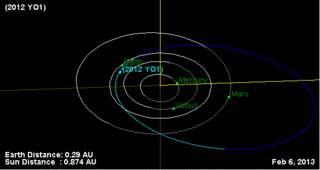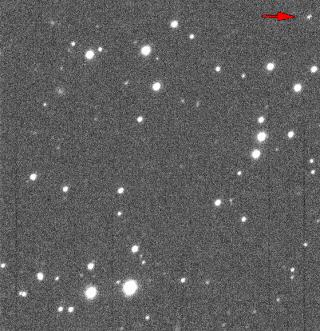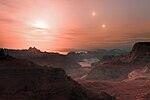Related Research Articles
(444004) 2004 AS1, provisional designation 2004 AS1, and also known by the temporary name AL00667, is a sub-kilometer asteroid, classified as near-Earth object and potentially hazardous asteroid of the Apollo group, approximately 300 meters in diameter.
2135 Aristaeus is an Apollo asteroid discovered on April 17, 1977, by E. F. Helin and S. J. Bus at Palomar Observatory. It is named for Aristaeus, the son of Apollo and the nymph Cyrene.

(276033) 2002 AJ129, provisional designation 2002 AJ129, is a Mercury-crossing asteroid. It has the ninth-smallest perihelion of all numbered asteroids, after asteroids such as 2000 BD19, 2004 UL, and 2008 XM. It makes close approaches to all of the inner planets and asteroid 4 Vesta. The asteroid is estimated to be between 0.5–1.2 kilometers (0.3–0.7 mi) across. In January 2018 there was much media hype about this asteroid being classified as a potentially hazardous asteroid, although there is no known threat of an impact for hundreds if not thousands of years. The media has compared the size of the asteroid to the Burj Khalifa in Dubai.
(529366) 2009 WM1, provisional designation 2009 WM1, is a sub-kilometer asteroid and near-Earth object of the Apollo group, approximately 280 meters (920 feet) in diameter. After its discovery by the Catalina Sky Survey at the Catalina Station in Arizona, United States, this potentially hazardous asteroid was briefly listed at a Torino Scale of 1 and a cumulative Palermo Scale of −0.87. It was removed from the Sentry Risk Table on 26 June 2013.
(242450) 2004 QY2 (prov. designation:2004 QY2) is an asteroid on an eccentric orbit, classified as near-Earth object and potentially hazardous asteroid of the Apollo group, approximately 3 kilometers (2 miles) in diameter. It was discovered on 20 August 2004 by the Siding Spring Survey at an apparent magnitude of 16.5 using the 0.5-metre (20 in) Uppsala Southern Schmidt Telescope. It is one of the largest potentially hazardous asteroids known to exist.

(669555) 2012 YQ1 is a sub-kilometer asteroid, classified as a near-Earth object and a potentially hazardous asteroid of the Apollo group, approximately 200 meters in diameter. It was first observed on 19 December 2012, by astronomers Andrey Oreshko and Timur Kryachko at the Elena Remote Observatory (G32) located in the Chilean Atacama desert.

(511002) 2013 MZ5, provisional designation 2013 MZ5, is a sub-kilometer asteroid, classified as a near-Earth object of the Amor group, estimated to measure approximately 300 meters (1,000 feet) in diameter. It was discovered on 18 June 2013, by astronomers with the Pan-STARRS survey at Haleakala Observatory on the island of Maui, Hawaii, in the United States. It was the 10,000th near-Earth object ever discovered.
(454101) 2013 BP73, provisional designation 2013 BP73, is a sub-kilometer asteroid, classified as a near-Earth object and potentially hazardous asteroid of the Apollo group, approximately 310 meters (1,020 ft) in diameter.
2011 EO40 is an asteroid, classified as a near-Earth object and a potentially hazardous asteroid of the Apollo group. It is a possible candidate for the parent body of the Chelyabinsk superbolide.

2000 EM26 is a sub-kilometer near-Earth object and potentially hazardous asteroid of the Aten group, approximately 110 meters (360 feet) in diameter. It was first observed by astronomers of the LINEAR program on 5 March 2000 and followed until 14 March 2000, by which time it had dimmed to apparent magnitude 20 and was 40° from the Moon. By 17 March 2000 it was only 4 degrees from a 90% waxing gibbous moon. It has never been listed on the Sentry Risk Table because none of the potential orbital solutions create a risk of impact in the next ~100 years. The asteroid safely passed Earth on 17–18 February 2014. Due to a then-poorly determined orbit, the asteroid may have been significantly further from Earth and dozens of degrees from where the telescope was pointed during the 2014 approach.
(672457) 2014 UR116, also known as 2008 XB, is an eccentric sub-kilometer asteroid, categorized as a near-Earth object and potentially hazardous asteroid of the Apollo group with a diameter of approximately 400 meters (1,300 ft). It was first observed on 1 December 2008, by the Mount Lemmon Survey at Mount Lemmon Observatory in Arizona, United States.
2012 UE34 is a sub-kilometer asteroid, classified as a near-Earth object of the Apollo group, approximately 70 meters (230 feet) in diameter. It was first observed on 18 October 2012, by Pan-STARRS at Haleakala Observatory on the island of Maui, Hawaii, in the United States. The object was removed from the Sentry Risk Table on 29 December 2013. On 8 April 2041 it will pass Earth at a nominal distance of 0.0007329 AU (110,000 km; 68,000 mi). Due to its presumed small size, it does not qualify as a potentially hazardous asteroid, despite its low Earth MOID.
(549948) 2011 WL2 is a sub-kilometer asteroid, classified as a near-Earth object and potentially hazardous asteroid of the Apollo group. It was discovered on 16 November 2011, by astronomers with the LINEAR at the Lincoln Laboratory ETS near Socorro, New Mexico, in the United States.
(585310) 2017 YZ1, provisional designation: 2017 YZ1, is a sub-kilometer asteroid on an eccentric orbit, classified as near-Earth object and potentially hazardous asteroid of the Apollo group, approximately 250 meters (800 feet) in diameter. It was first observed on 20 December 2017, by astronomers with the Mount Lemmon Survey at Mount Lemmon Observatory near Tucson, Arizona, in the United States. On 29 January 2018, it passed Earth at 125 lunar distances.

2010 WC9, unofficially designated ZJ99C60, is a sub-kilometer near-Earth asteroid of the Apollo group, approximately 100 meters (330 feet) in diameter. First observed for eleven days by the Catalina Sky Survey in 2010, the asteroid was recovered in May 2018 during its sub-lunar close encounter with Earth.

2018 XB4 (also written 2018 XB4) is an Apollo near-Earth asteroid roughly 53 meters (170 feet) in diameter. It was discovered on 13 December 2018 when the asteroid was about 0.125 AU (18,700,000 km; 11,600,000 mi) from Earth and had a solar elongation of 146°. It passed closest approach to Earth on 1 January 2019. Of the asteroids discovered in 2018, it had the highest Palermo scale rating at –3.6. In mid-2019 it was recovered which extended the observation arc to 177 days and was removed from the Sentry Risk Table on 12 June 2019. It is now known that on 22 June 2092 the asteroid will pass about 0.033±0.015 AU from Earth.
2014 MV67 (also written 2014 MV67) is a Mars-crosser and former lost asteroid with an observation arc of less than 1 day. Before its recovery, it had an assumed orbital eccentricity and a very poorly constrained orbit. Depending on the orbit, it could have been a potentially hazardous asteroid, roughly 540 meters (1,770 feet) in diameter, or it could turn out to be a Mars-crosser or even a main-belt asteroid as were the cases with 2004 BX159 and 2010 GZ60. It was recovered by Pan-STARRS in September 2021 and is now known to be a Mars-crossing asteroid.
2007 FT3 (also written 2007 FT3) is a lost asteroid with a short observation arc of 1.2 days that cannot be recovered with targeted observations and awaits serendipitous survey observations. It has a poorly constrained orbit and has not been seen since 2007. It was first observed on 20 March 2007 when the asteroid was estimated to be 0.19 ± 0.01 AU (28.4 ± 1.5 million km) from Earth and had a solar elongation of 107 degrees. 2007 FT3 is the fourth largest asteroid with better than a 1-in-2 million cumulative chance of impacting Earth after (29075) 1950 DA, 1979 XB, and 101955 Bennu. With a cumulative Palermo Technical Impact Hazard Scale of -2.63, the poorly known orbit and assumed size place 2007 FT3 third on an unconstrained listing of the Sentry Risk Table.
1979 XB is a lost asteroid with a short observation arc of 3.9 days that cannot be recovered with targeted observations and awaits serendipitous survey observations. It is classified as a near-Earth object and potentially hazardous asteroid of the Apollo group and is estimated to be 660 meters in diameter. The unnumbered minor planet has a poorly constrained orbit and has not been observed in 45 years. It has been listed on the Sentry Risk Table since the list started in 2002. With a cumulative Palermo Technical Impact Hazard Scale of −2.72, the poorly known orbit and assumed size place 1979 XB third on an unconstrained listing of the Sentry Risk Table.

2020 VV is an Apollo near-Earth asteroid roughly 12 meters in diameter. On 20 November 2020, the asteroid had a 4.4% chance of impacting Earth on 12 October 2033 11:43 UT. As of mid-December 2020, the asteroid has a modest 61 day observation arc. The nominal Earth approach is on 17 October 2033 at a distance of 0.009 AU, but the line of variations (LOV) is only known with an accuracy of ±22 hours. The line of variations allows the asteroid to come as close as 0.006 AU or pass as far away as 0.01 AU. With a diameter range of 10–22 meters the asteroid could be as large as the Chelyabinsk meteor.
References
- 1 2 3 4 "523662 (2012 MU2)". Minor Planet Center. Retrieved 9 October 2018.
- 1 2 3 4 5 "JPL Small-Body Database Browser: 523662 (2012 MU2)" (2018-09-12 last obs.). Jet Propulsion Laboratory . Retrieved 9 October 2018.
- 1 2 3 "Observations of small Solar-System bodies (2012 MU2)". hohmanntransfer. 23 June 2012. Retrieved 8 September 2013.
- ↑ "MPEC 2012-M24 : 2012 MU2". IAU Minor Planet Center. 20 June 2012. Retrieved 8 September 2013. (K12M02U)
- ↑ "Date/Time Removed". NASA/JPL Near-Earth Object Program Office. Archived from the original on 2 June 2002. Retrieved 8 September 2013.
- 1 2 3 4 "JPL Close-Approach Data: (2012 MU2)" (last observation: 2015-06-14; arc: 1091 days). Retrieved 3 July 2015.
- ↑ "MPC/MPO/MPS Archive". Minor Planet Center. Retrieved 9 October 2018.


